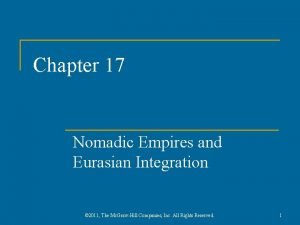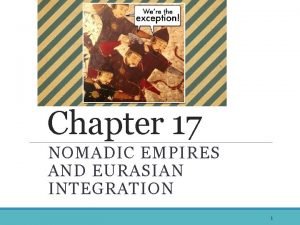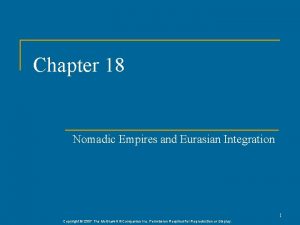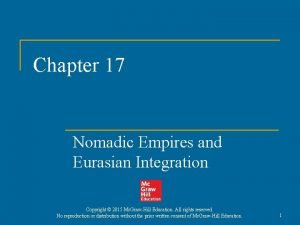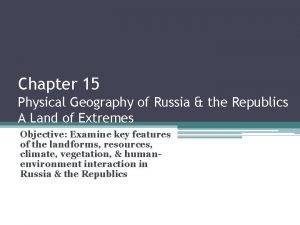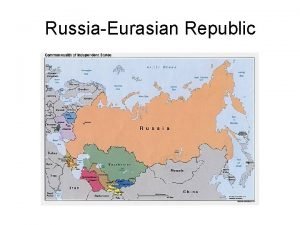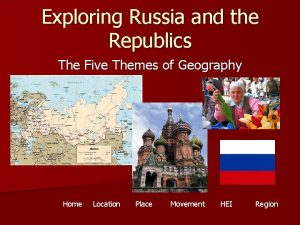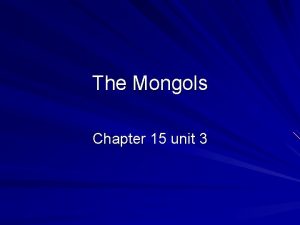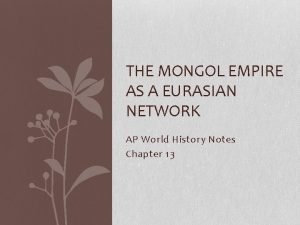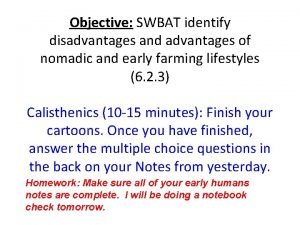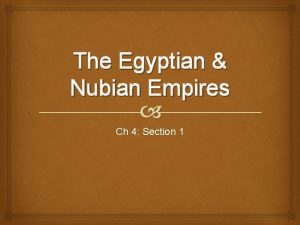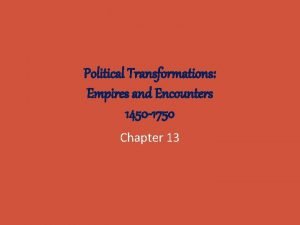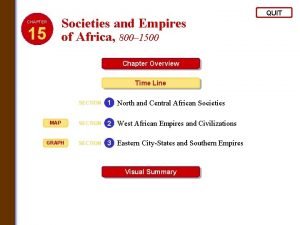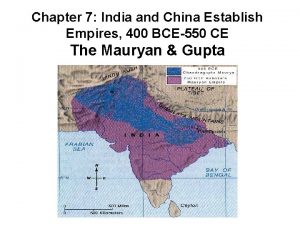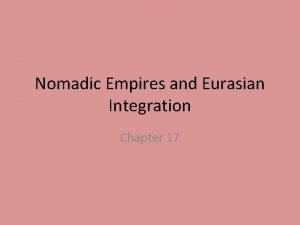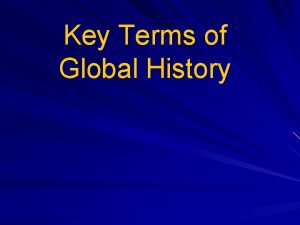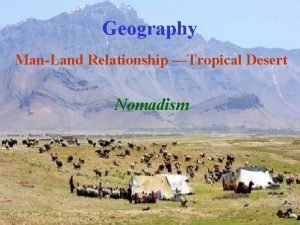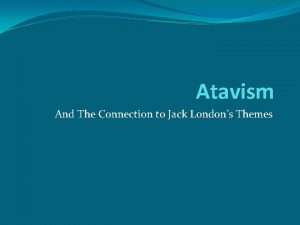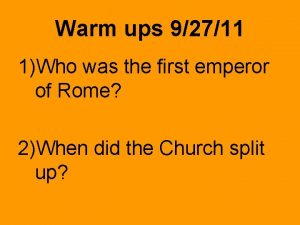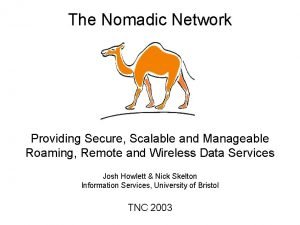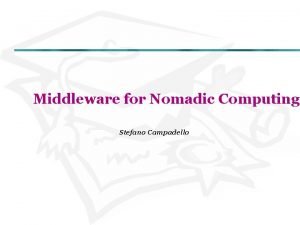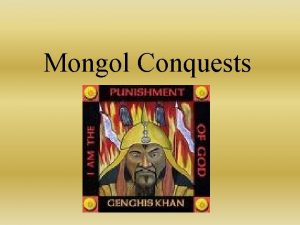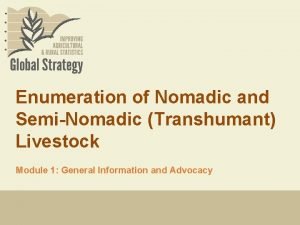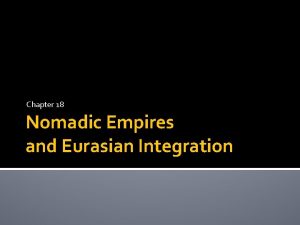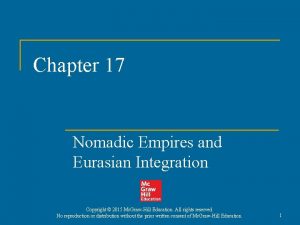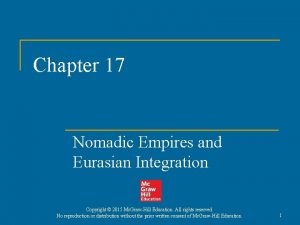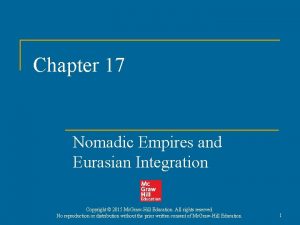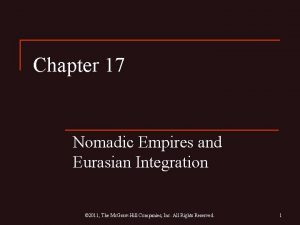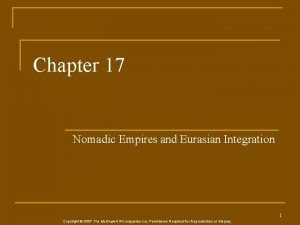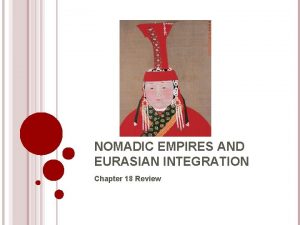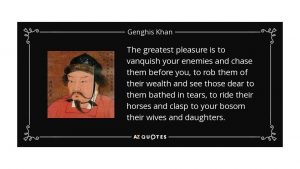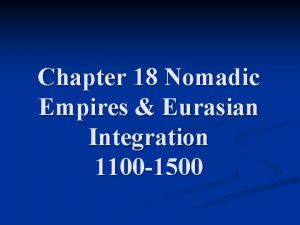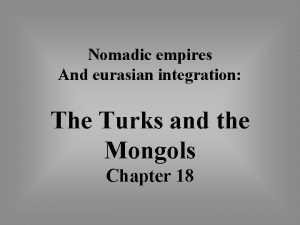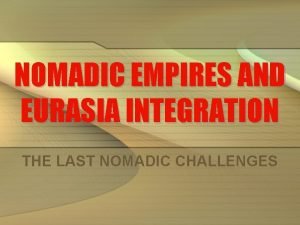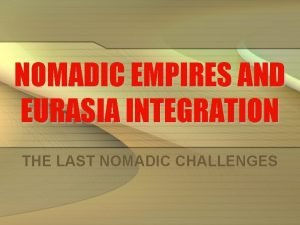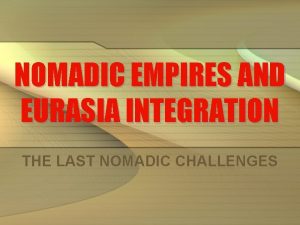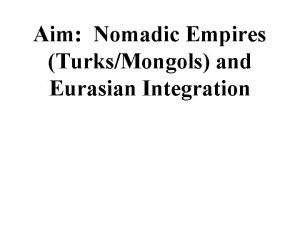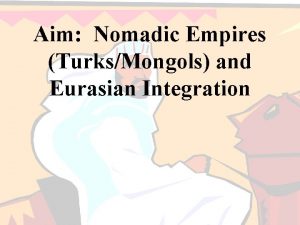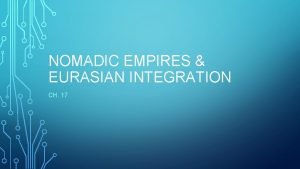Chapter 17 Nomadic Empires and Eurasian Integration Copyright
































- Slides: 32

Chapter 17 Nomadic Empires and Eurasian Integration Copyright © 2015 Mc. Graw-Hill Education. All rights reserved. No reproduction or distribution without the prior written consent of Mc. Graw-Hill Education. 1

Economy and Society of Nomadic Pastoralism n n Rainfall in central Asia too little to support large-scale agriculture Animal herding q n n n Food; clothing; shelter (yurts) Migratory patterns to follow pastureland Small-scale cultivation Limited amounts of pottery, leather goods, weapons and tools Copyright © 2015 Mc. Graw-Hill Education. All rights reserved. No reproduction or distribution without the prior written consent of Mc. Graw-Hill Education. 2

Nomadic and Settled Peoples n n Trade links between nomadic and settled peoples Nomads engage in long-distance travel q Caravan routes Copyright © 2015 Mc. Graw-Hill Education. All rights reserved. No reproduction or distribution without the prior written consent of Mc. Graw-Hill Education. 3

Nomadic Society n n n Governance basically clan-based Charismatic individuals became elite leaders, occasionally asserted authority Unusually fluid status for elites q q Hereditary, but could be lost through incompetence Advancement for meritorious commoners Copyright © 2015 Mc. Graw-Hill Education. All rights reserved. No reproduction or distribution without the prior written consent of Mc. Graw-Hill Education. 4

Gender Relations n Women wielded considerable influence q q Advisors Occasionally regents or rulers Copyright © 2015 Mc. Graw-Hill Education. All rights reserved. No reproduction or distribution without the prior written consent of Mc. Graw-Hill Education. 5

Nomadic Religion n n Shamans center of pagan worship Appeal of Buddhism, Nestorian Christianity, Islam, Manichaeism from sixth century C. E. Turkish script developed, partially to record religious teachings Conversion to Islam in tenth century due to Abbasid influence Copyright © 2015 Mc. Graw-Hill Education. All rights reserved. No reproduction or distribution without the prior written consent of Mc. Graw-Hill Education. 6

Military Organization n Large confederations under a khan Authority extended through tribal elders Exceptionally strong cavalries q q Mobility Speed Copyright © 2015 Mc. Graw-Hill Education. All rights reserved. No reproduction or distribution without the prior written consent of Mc. Graw-Hill Education. 7

Turkish Empires and Their Neighbors, ca. 1210 C. E. Copyright © 2015 Mc. Graw-Hill Education. All rights reserved. No reproduction or distribution without the prior written consent of Mc. Graw-Hill Education. 8

Saljuq Turks and the Abbasid Empire n Eighth to tenth centuries, Turkish peoples on border of Abbasid empire q n n Eventually came to dominate Abbasid caliphs Tughril Beg recognized as sultan, 1055 q n Service in Abbasid armies Consolidated hold on Baghdad, then extended rule to other parts of empire Abbasid caliphs served as figureheads of authority Copyright © 2015 Mc. Graw-Hill Education. All rights reserved. No reproduction or distribution without the prior written consent of Mc. Graw-Hill Education. 9

Saljuq Turks and the Byzantine Empire n Defeat of Byzantine army by Saljuq Turks at Manzikert, 1071 q n n n Emperor taken captive Large-scale invasion of Anatolia Many conversions to Islam Constantinople conquered by Ottoman Turks, 1453 Copyright © 2015 Mc. Graw-Hill Education. All rights reserved. No reproduction or distribution without the prior written consent of Mc. Graw-Hill Education. 10

Ghaznavid Turks and the Sultanate of Delhi n n Invasion of northern India by Mahmud of Ghazni, Turkish Ghaznavids of Afghanistan At first for plunder, later to rule Northern India completely dominated by thirteenth century Persecution of Buddhists, Hindus Copyright © 2015 Mc. Graw-Hill Education. All rights reserved. No reproduction or distribution without the prior written consent of Mc. Graw-Hill Education. 11

Chinggis Khan (1167– 1227) and the Making of the Mongol Empire n Temüjin, b. 1167 q q Father prominent warrior, poisoned ca. 1177, Temüjin forced into poverty Mastered steppe diplomacy, elimination of enemies Brought all Mongol tribes into one confederation Proclaimed Chinggis Khan (“universal ruler”), 1206 Copyright © 2015 Mc. Graw-Hill Education. All rights reserved. No reproduction or distribution without the prior written consent of Mc. Graw-Hill Education. 12

Mongol Political Organization n n Broke up tribal organization Formed military units from men of different tribes Promoted officials on basis of merit and loyalty Established capital at Karakorum Copyright © 2015 Mc. Graw-Hill Education. All rights reserved. No reproduction or distribution without the prior written consent of Mc. Graw-Hill Education. 13

Mongol Arms n Mongol population only one million (less than 1% of Chinese population) q n Army numbered 100, 000– 125, 000 Strengths: q q q Cavalry Short bows Rewarded enemies who surrendered, cruel to enemies who fought Copyright © 2015 Mc. Graw-Hill Education. All rights reserved. No reproduction or distribution without the prior written consent of Mc. Graw-Hill Education. 14

Mongol Conquests n n Conquest of northern China by 1220 Conquest of Afghanistan, Persia q q q Mongol envoys to Kwarazm shah murdered Following year, Chinggis Khan pursued shah to his death Ravaged lands to prevent future rebellions n n Large-scale, long-term devastation Destruction of qanat irrigation system Copyright © 2015 Mc. Graw-Hill Education. All rights reserved. No reproduction or distribution without the prior written consent of Mc. Graw-Hill Education. 15

The Mongol Empires, ca. 1300 C. E. Copyright © 2015 Mc. Graw-Hill Education. All rights reserved. No reproduction or distribution without the prior written consent of Mc. Graw-Hill Education. 16

Khubilai Khan (r. 1264– 1294) n n n Grandson of Chinggis Khan Rule of China Ruthless warrior, but religiously tolerant Established Yuan dynasty (to 1368) Unsuccessful forays into Vietnam, Cambodia, Burma, Java Two attempted invasions of Japan (1274, 1281) turned back by typhoons (kamikaze: “divine winds”) Copyright © 2015 Mc. Graw-Hill Education. All rights reserved. No reproduction or distribution without the prior written consent of Mc. Graw-Hill Education. 17

The Golden Horde n Conquest of Russia, 1237– 1241 q q n Established tributary relationship to fifteenth century Ruled over Crimea to late eighteenth century Raids into Poland, Hungary, Germany Copyright © 2015 Mc. Graw-Hill Education. All rights reserved. No reproduction or distribution without the prior written consent of Mc. Graw-Hill Education. 18

The Ilkhanate of Persia n n Abbasid empire toppled by Hülegü (Khubilai’s brother) Baghdad sacked, 1258 q n 200, 000 massacred Expansion into Syria checked by Egyptian forces Copyright © 2015 Mc. Graw-Hill Education. All rights reserved. No reproduction or distribution without the prior written consent of Mc. Graw-Hill Education. 19

Mongol Rule in Persia n Nomadic conquerors had to learn to rule sedentary societies q n Persia: dependence on existing administration to deliver tax revenues q n Inexperienced, lost control of most lands within a century Left matters of governance to bureaucracy Eventually assimilated into Islamic lifestyle Copyright © 2015 Mc. Graw-Hill Education. All rights reserved. No reproduction or distribution without the prior written consent of Mc. Graw-Hill Education. 20

Mongol Rule in China n Strove to maintain strict separation from Chinese q q n n Intermarriage forbidden Chinese forbidden to study Mongol language Imported administrators from other areas (especially Arabs, Persians) Yet tolerated religious freedoms Copyright © 2015 Mc. Graw-Hill Education. All rights reserved. No reproduction or distribution without the prior written consent of Mc. Graw-Hill Education. 21

The Mongols and Buddhism n n Shamanism remained popular Lamaist school of Buddhism (Tibet) gained strength among Mongols q q Large element of magic, similar to shamanism Ingratiating attitude to Mongols: khans as incarnations of Buddha Copyright © 2015 Mc. Graw-Hill Education. All rights reserved. No reproduction or distribution without the prior written consent of Mc. Graw-Hill Education. 22

The Mongols and Eurasian Integration n Experience with long-distance trade q q n n n Protection of traveling merchants Increased volume of trade across central Asia Diplomatic missions protected Missionary activity increased Mongol resettlement policies Copyright © 2015 Mc. Graw-Hill Education. All rights reserved. No reproduction or distribution without the prior written consent of Mc. Graw-Hill Education. 23

Decline of the Mongols in Persia n n Overspending, poor tax returns from overburdened peasantry Ilkhan attempted to replace precious metal currency with paper in 1290 s q n n Failure, forced to rescind Factional fighting Last ilkhan died without heir in 1335; Mongol rule collapsed Copyright © 2015 Mc. Graw-Hill Education. All rights reserved. No reproduction or distribution without the prior written consent of Mc. Graw-Hill Education. 24

Decline of the Yuan Dynasty n Mongols spent bullion that supported paper currency q q n n n Public lost confidence in paper money Sharp rise in prices From 1320 s, major power struggles Spread of bubonic plague, 1330 s– 1340 s 1368, Mongols fled from peasant rebellion Copyright © 2015 Mc. Graw-Hill Education. All rights reserved. No reproduction or distribution without the prior written consent of Mc. Graw-Hill Education. 25

Surviving Mongol Khanates n Khanate of Chaghatai in central Asia q n Continued threat to China Golden Horde in Caucasus and steppes to mid-sixteenth century q Continued threat to Russia Copyright © 2015 Mc. Graw-Hill Education. All rights reserved. No reproduction or distribution without the prior written consent of Mc. Graw-Hill Education. 26

Tamerlane (ca. 1336– 1405) and the Timurids n Turkic-Mongol conqueror Timur q n n Timur the Lame: Tamerlane Eliminated rivals to power Major military campaigns q Built capital in Samarkand Copyright © 2015 Mc. Graw-Hill Education. All rights reserved. No reproduction or distribution without the prior written consent of Mc. Graw-Hill Education. 27

Tamerlane’s Empire, ca. 1405 C. E. Copyright © 2015 Mc. Graw-Hill Education. All rights reserved. No reproduction or distribution without the prior written consent of Mc. Graw-Hill Education. 28

Tamerlane’s Heirs n n n Poor organization of governing structure Power struggles divided Timurid empire into four regions Yet heavily influenced several empires: q q q Mughal Safavid Ottoman Copyright © 2015 Mc. Graw-Hill Education. All rights reserved. No reproduction or distribution without the prior written consent of Mc. Graw-Hill Education. 29

The Foundation of the Ottoman Empire n n n Osman, charismatic leader who dominated part of Anatolia Declared independence from Saljuq sultan, 1299 Attacked Byzantine empire q Followers known as Osmanlis or Ottomans Copyright © 2015 Mc. Graw-Hill Education. All rights reserved. No reproduction or distribution without the prior written consent of Mc. Graw-Hill Education. 30

Ottoman Conquests in the Balkans, 1350 s q q n Local support for Ottoman invasion Peasants unhappy with fragmented, ineffective Byzantine rule Tamerlane defeated Ottoman forces in 1402, but Ottomans recovered by 1440 s Copyright © 2015 Mc. Graw-Hill Education. All rights reserved. No reproduction or distribution without the prior written consent of Mc. Graw-Hill Education. 31

The Capture of Constantinople, 1453 n Sultan Mehmed II q q n n Sacked city Renamed Istanbul, capital of Ottoman empire Ottomans quickly absorbed remainder of Byzantine empire Continued to expand Copyright © 2015 Mc. Graw-Hill Education. All rights reserved. No reproduction or distribution without the prior written consent of Mc. Graw-Hill Education. 32
 Chapter 17 nomadic empires and eurasian integration
Chapter 17 nomadic empires and eurasian integration Chapter 17 nomadic empires and eurasian integration
Chapter 17 nomadic empires and eurasian integration Chapter 18 nomadic empires and eurasian integration
Chapter 18 nomadic empires and eurasian integration Chapter 17 nomadic empires and eurasian integration
Chapter 17 nomadic empires and eurasian integration How are maritime and land based empires similar
How are maritime and land based empires similar Russia and the eurasian republics physical map
Russia and the eurasian republics physical map Eurasian countries map
Eurasian countries map Russia and the eurasian republics physical map
Russia and the eurasian republics physical map Chapter 15 the last great nomadic challenges
Chapter 15 the last great nomadic challenges The mongol empire as a eurasian network
The mongol empire as a eurasian network Advantages and disadvantages of nomadic herding
Advantages and disadvantages of nomadic herding Chapter 4 section 1 the egyptian and nubian empires
Chapter 4 section 1 the egyptian and nubian empires Chapter 5 political transformations empires and encounters
Chapter 5 political transformations empires and encounters Aztec farming
Aztec farming Chapter 15 societies and empires of africa
Chapter 15 societies and empires of africa Chapter 7 india and china establish empires
Chapter 7 india and china establish empires Three dimensions of corporate strategy
Three dimensions of corporate strategy Make or buy continuum
Make or buy continuum Simultaneous integration meaning
Simultaneous integration meaning Nomadic religion
Nomadic religion Nomads world history definition
Nomads world history definition Nomadic herding definition ap human geography
Nomadic herding definition ap human geography Atavism poem
Atavism poem Why do geographers call arabia a crossroads location
Why do geographers call arabia a crossroads location Nomadic network
Nomadic network Nomadic user disebut juga
Nomadic user disebut juga Islamic jeopardy questions
Islamic jeopardy questions Nomadic computing examples
Nomadic computing examples Language youtube
Language youtube Mongols vs vikings
Mongols vs vikings The nomadic network
The nomadic network Nomadic peoples who herded domesticated animals
Nomadic peoples who herded domesticated animals Gsars
Gsars
